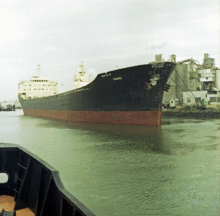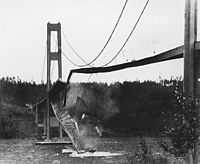West Seattle Bridge
| West Seattle Bridge | |
|---|---|
 The West Seattle Bridge from the 12th Avenue South Viewpoint on Beacon Hill. | |
| Coordinates | 47°34′15″N 122°21′01″W / 47.570945°N 122.350338°WCoordinates: 47°34′15″N 122°21′01″W / 47.570945°N 122.350338°W |
| Carries | vehicles |
| Crosses | Duwamish Waterway |
| Locale | Seattle, Washington |
| Other name(s) | Jeanette Williams Memorial Bridge |
| Characteristics | |
| Design | segmental, cantilever |
| Total length | 2,607 ft (795 m)[1] |
| Clearance below | 140 ft (42.6 m) |
| History | |
| Opened | July 14, 1984[2] |
The high-level West Seattle Bridge, officially the Jeanette Williams Memorial Bridge, is a cantilevered segmental bridge that serves as the primary connection between West Seattle and the rest of the city. It was built between 1981 and 1984 after the previous bascule bridge was deemed inoperable as a result of being struck by the Chavez freighter in 1978.
The bridge spans the east and west channels that form the mouth of the Duwamish River at Elliott Bay, crossing over Harbor Island. Its main approaches are Fauntleroy Way S.W. from the west and the Spokane Street Viaduct from the east. The viaduct continues east to Interstate 5 at Columbian Way (exit 163), forming a three-mile (5 km) arterial between West Seattle and I-5. The navigational clearance height of the high-level West Seattle Bridge is 140 feet (42.6 meters).[3]
The low-level Spokane Street Bridge of swing-span design spans the west channel of the Duwamish River immediately north of the high-level bridge. The low-level bridge carries the surface-level Spokane Street and has a navigational clearance of 45 feet (13.7 meters).
History
The original bridge was a low-level bascule bridge constructed in 1924. By the 1970s, it was one of Seattle's worst bottlenecks, due to the large number of ships in Duwamish Waterway and the frequent bridge openings. City leaders began planning a higher bridge, without a drawbridge, in the 1960s.
Planning for the bridge was hampered by difficulties in receiving funding. In large part, this is because the bridge was not a designated highway. A 1968 Forward Thrust ballot measure included $16.7 million in funding for the bridge, largely to receive votes from West Seattle residents. Other funding sources included a state program for funding urban streets and money from a maintenance fund.
After a long drawn-out process, three companies eventually bid to design the bridge for $1.5 million. However, the city engineer chose a fourth company that was financially connected to the speaker of the state house. The price from this fourth company was triple the cost of the other three. This was a result of a series of bribes involving the head of the House Transportation Committee, the city engineer and others. Despite the 68 percent support in the 1968 ballot measure, the state withdrew its urban streets money due to the scandal. In 1976 and 1977, the conspirators were placed on trial and imprisoned.
After the scandal, the project was considered dead. Norbert Tiemann, a federal highway regulator, stated that there would essentially be no chance of the project receiving federal funds for completion. Tiemann also quipped, "Short of a tug knocking it down (which could trigger federal special bridge replacement funds), there is nothing else. And you certainly wouldn't want to go that route."[4]

In 1978, a ship actually did strike the bridge, which left the 1924 bridge stuck open and unrepairable. Because of this, the project qualified for funds from the federal Office of Special Bridge Replacement. However, with many other damaged bridges to replace, this program alone did not have sufficient funding. While federal lawmakers were opposed to appropriating funds to a high-level bridge, Seattle City Council member Jeanette Williams lobbied Congress for the bridge and successfully secured funds with help from Senator Warren Magnuson. The bridge was complete in 1984, and the smaller Spokane Street Bridge which parallels it was built at the same time.
Before the bridge opened, many of the neighborhoods in West Seattle had low property values because of the difficulty in getting downtown. The bridge caused an increase in property values as well as a development boom, as developers constructed new multi-family housing. This new development also led to an increase in traffic volumes throughout the neighborhood.
The West Seattle Bridge was renamed as the Jeanette Williams Memorial Bridge on July 6, 2009, in honor of Jeanette Williams, who served on the Seattle City Council from 1970 to 1989, and was instrumental in securing political support for the construction of the bridge.[5][6] However, all directional signs continue to carry the name "West Seattle Bridge."
From 2008 to 2013, the Spokane Street Viaduct section between Interstate 5 and WA 99 was rebuilt and widened. The Spokane Street Viaduct section was one of Seattle's first freeways, built in 1940. The widened roadway has three lanes in each direction and shoulders. A new westbound on and off ramp was built at 1st Ave S and replaced the dangerous 4th Ave S off-ramp. A new eastbound off-ramp to 4th Ave S opened August 16, 2010. The new roadway may be considered for an interstate designation after the upgrade as it connects to the Port of Seattle.
Exit list
| Destinations | Notes |
|---|---|
| Fauntleroy Way Southwest, 35th Avenue Southwest | Ends at an at-grade intersection |
| Admiral Way | Westbound exit and eastbound entrance |
| Harbor Avenue, Avalon Way | Westbound exit and eastbound entrance |
| Delridge Way Southwest, Southwest Spokane Street - South Seattle Community College | Westbound exit and eastbound entrance |
| 11th Avenue Southwest - Harbor Island, Terminal 18 | Westbound exit and eastbound entrance |
| Eastbound exit and westbound entrance | |
| 1st Avenue South | Eastbound exit; westbound exit and entrance |
| 4th Avenue South | Eastbound exit |
| Spokane Street, 6th Avenue South | Westbound exit and eastbound entrance |
| Columbian Way, 15th Avenue South | Eastbound exit and westbound entrance |
See also
- Spokane Street Bridge, the "low" bridge that makes the same crossing.
Notes
- ↑ "West Seattle Bridge Ceremonially Renamed the "Jeanette Williams Memorial Bridge"" (Press release). Seattle City Council. 23 October 2009. Retrieved 2011-07-03.
- ↑ Long, Priscilla (May 29, 2007). "West Seattle Bridge is dedicated on July 14, 1984.". HistoryLink. Retrieved August 22, 2014.
- ↑ "U.S. Coast Guard Bridge Guide Clearances".
- ↑ Bob Royer (June 20, 2011). "When the Ship Hit the Span". Cascadia Courier. Retrieved May 26, 2014.
- ↑ "You can call it the Jeanette Williams Memorial Bridge". WestSeattleBlog, 23 October 2009.
- ↑ "West Seattle Bridge renamed to honor Jeanette Williams". West Seattle Herald, 23 October 2009.
External links
| Wikimedia Commons has media related to West Seattle Bridge. |
| |||||||||||||||||||||
| ||||||||||||||||||||||||||||
| |||||||||
